Thadeus Geodfrey is a leading voice in the financial industry. You’ll appreciate the expert ease with which he does this. He deciphers the intricate link between emotions and behavior in trading and investment. With extensive experience as a senior trading writer, Thadeus imparts his knowledge and confidence to guide your trading boat. He’ll make you conquer your fears, break barriers, and capitalize on every potential opportunity. Follow his pieces and develop your knack for trading.
We may receive compensation from our partners for placement of their products or services, which helps to maintain our site. We may also receive compensation if you click on certain links posted on our site. While compensation arrangements may affect the order, position or placement of product information, it doesn’t influence our assessment of those products.
Contract for Difference, popularly known as CFDs, are popular financial instruments that you can add to your investment portfolio and earn significant profits. However, these instruments are complicated, and it’s important for beginner traders to learn how they work before getting started. For this reason, we have prepared this CFD trading for beginners guide, uncovering all the information you need to decide whether CFDs are the best instruments to invest in.
What is CFD Trading?

CFD trading is the buying and selling of financial derivatives, which lets you speculate on whether the price of an asset will rise or fall. CFD trading also represents a contract between the trader and the CFD broker to exchange the price difference of an instrument from the time the contract is entered to the time it’s closed. CFD brokers offer a variety of financial instruments, including stocks, cryptos, commodities, and forex.
How Does CFD Trading Work?
CFD trading is all about speculating whether the price of an asset will rise or fall. If you think the price of a financial instrument or asset will rise, you will “go long” or buy a CFD. On the other hand, if you think the price of an asset will fall, you will “go short” or sell a CFD.
Making profits in CFD trading depends on how accurate you are with the predictions. If you make a profit, the CFD broker who entered into the contract with you will pay you the price difference between the time the contract was entered and the time the contract ended. But if you lose, you will have to pay the CFD broker the price difference.
To calculate your profit or loss, you need to multiply the price difference by the number of CDF units bought or sold. For example, suppose you buy 1000 shares at $20 each. If you close the trade when the price of each share is $22, you would make a profit of $2 per share. This means the net profit would be (1000 x 2) =$2000. But if you close the contract when the price of each share is $18, you would make a loss of $2000.
Keep in mind that CFDs act as derivatives, which means you will trade without taking ownership of the assets. In fact, they are called derivatives because they derive their value from the price movements of a particular asset. You also need to note that, unlike future contracts, CFDs have no expiration dates, and investors can hold them indefinitely. However, be warned that long positions that last more than a day attract overnight fees.
Another thing to note is that CFD traders have the opportunity to enjoy leverage. A leverage of 100:1, for example, means that you can magnify your initial capital up to 100 times. So, if you have $500 in your CFD account, you can trade with $50000. But don’t get too excited yet; leverage can also magnify your losses.
How to Trade CFD
If you are ready to start your CFD trading adventure, follow these five simple steps:
The first thing you need to do is to choose a CFD broker. As you already know, trading CFD involves money, so it’s important to select a trusted broker. Beyond that, check if the broker has a variety of financial instruments, the platform’s user-friendliness, and the available educational resources. And don’t forget to pick a broker that allows you to trade with a demo account.
After finding a reputable CFD broker, visit the official website and register an account. The broker will request details like email address, name, and date of birth. Once you are done with registration, head to the deposit page and transfer the amount you want to trade with. Be sure to check the minimum deposit needed to start trading.
Your chosen CFD broker should have a wide range of financial instruments for you to pick from. Most brokers offer forex, cryptocurrencies, indices, commodities, and stocks. This step is critical because choosing a financial market you don’t know about could lead to huge losses. Some brokers have education resources and CFD trading tips, so be sure to utilize them.
Now that you have chosen your market, you can proceed to place the first trade. At this point, you need to decide on the position size and whether you want to buy or sell. You buy if you think the price will rise and sell if you think the price will go down. This is also the point where you will set your stops and limits. Well, these are parameters that close the contract automatically once it reaches the preferred profits or losses.
Most CFD trading platforms let you watch your active trades in real-time. You can close them if you are comfortable with profits or losses made.
Risks of Trading CFDs

Like any other investment, CFD trading has a couple of risks that you need to be aware of before you start trading. The risks include:
- Leverage risks – Leverage doubles as a benefit for CFD trading and risk. While leverage can magnify your profits, it can also magnify losses with the same amount if the trade moves against your way. For example, if you have a leveraged trade worth $2000 and the market moves against you by 20%, you could lose $400.
- Market volatility – Most financial markets, especially crypto markets, fluctuate rapidly, causing gapping risks. Well, gapping risks are a result of assets’ prices moving quickly from one level to another while skipping the levels in between. When this happens, the contracts are executed at prices lower or higher than what you wanted.
- Holding costs – As a CFD trader, be ready to incur holding costs, which vary depending on how long your position is. If you hold a position for a long time, you may incur huge costs, which may exceed the expected profits.
- Account close-out – This risk arises as a result of market volatility. If prices of assets change rapidly outside business hours and you don’t have enough funds to cover these situations, your positions are closed automatically. In other words, the platform will execute the trade if your balance is below the close-out levels.
Factors to Consider Before Trading CFDs
Trading on CFDs is not like any other ordinary business that can wake up and decide to venture into. Several factors are crucial to your success, and it’s, therefore, important you consider them before placing your first CFD trade.
You need to consider:
- Regulation and safety – There are so many fraudulent brokers out there, so you need to be careful when selecting the platform to join. You need to check if the broker is licensed and regulated by a well-known authority. That way, you will always have a place to lodge your complaints if the broker violates your rights.
- Understand all risks – CFD trading is one of the riskiest businesses out there. To this end, you need to be aware of all the risks involved before you start trading. When you are aware of the risks, you can come up with a way to minimize them.
- Margin requirement – The margin requirement affects the size of your position, so it’s essential you consider it when choosing a CFD broker. If you want to control a large position, you need to pick a broker without a tight leverage cap.
- Trading tools – Trading tools are crucial for your success as they provide insights into what is happening in the market. Therefore, you should consider joining a platform that gives you access to market analysis tools, news feeds, and the Commitment of Traders (COT) reports.
FAQs
CFD, or contract for difference, is a contract between the trader (buyer) and the broker (seller) that speculates the price moment of a financial instrument. The two parties agree to exchange the price difference from the time a contract is agreed on to the time it’s closed.
Trading CFDs is safe as long as you are doing it with a reputable broker. However, there are many risks involved, including leverage risks, market volatility, and holding costs. Make sure you are aware of all these risks before getting into it.
Yes, it’s possible to make money if the trade moves your way. But if the trade goes the other way, you will be counting losses.
No, it’s not illegal to trade CFDs. However, you need to check if laws in your jurisdiction allow trading on CFDs.
Conclusion
CFD trading is a great opportunity for investors who like taking high risks for a chance to make big profits. If you are a novice trader, we hope our CFD trading for beginners guide has enlightened you. Before placing your first trade, understand all the risks involved, learn the basics, and start with the financial markets you are familiar with. Most importantly, start your trading journey with a regulated CFD broker.
